Browse Primary Sources
Locate primary sources, including images, objects, media, and texts. Annotations by scholars contextualize sources.

Speculum Historiale by Vincent of Beauvais
Earlier accounts of Charlemagne’s life, rife with positive bias though many may be, pale in comparison to the heavily legendary account present in the thirteenth century’s memory of Charlemagne. By the time that the Dominican Vincent of Beauvais wrote his Speculum Historiale (Historical Mirror), the figure of Charlemagne had become infused with the stuff of legend and myth.

Deeds of Emperor Charles the Great
Later in the 9th century, Notker “the Stammerer” of St.-Gall wrote his Gesta Karoli Magni Imperatoris (Deeds of Emperor Charles the Great). He dedicated the work to Charlemagne’s great-grandson Charles the Fat (r. 876-888), a son of Louis the German, and indeed, Notker intended the work, at least in part, to serve as an exempla for Charles the Fat on the proper way to rule a kingdom.

Excerpts from the Vita Karoli Magni
Let us investigate the work of Charlemagne’s courtier Einhard, the Vita Karoli Magni, or Life of Charles the Great, which was composed during the reign of Louis the Pious, probably during the long decade from around 817-830. Einhard owed his position at court to Charlemagne, and he continued to serve Charles’s son and successor, Louis the Pious, after Charlemagne’s death.
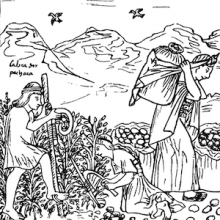
Illustrations from Guaman Poma, El Primer Nueva Coránica y Buen Gobierno
These two illustrations come from El Primer Nueva Coránica y Buen Gobierno [The First New Chronicle and Good Government] (1615), a history of the Inca Empire and the Spanish conquest of the Andes written and illustrated by Filipe Guaman Poma y Ayala, an indigenous Peruvian Christian noble. The book is written primarily in Spanish, with some Quecha words.

Extract from Garcilaso de la Vega, Royal Commentaries of the Incas and General History of Peru
This is an extract from the chronicles of Garcilaso de la Vega (1539–1616), the son of a Spanish conquistador and an Inca noble woman, who grew up in Peru but left there as a young man and spent the rest of his life in Spain. His descriptions of the laws and actions of the Incas are based on oral traditions that he had heard as a child, along with some earlier written chronicles.

Extract from Garcilaso de la Vega, Royal Commentaries of the Incas and General History of Peru
This is an extract from the chronicles of Garcilaso de la Vega (1539–1616), the son of a Spanish conquistador and an Inca noble woman, who grew up in Peru but left there as a young man and spent the rest of his life in Spain. His descriptions of the laws and actions of the Incas are based on oral traditions that he had heard as a child, along with some earlier written chronicles.

Extract from Garcilaso de la Vega, Royal Commentaries of the Incas and General History of Peru
This is an extract from the chronicles of Garcilaso de la Vega (1539–1616), the son of a Spanish conquistador and an Inca noble woman, who grew up in Peru but left there as a young man and spent the rest of his life in Spain. His descriptions of the laws and actions of the Incas are based on oral traditions that he had heard as a child, along with some earlier written chronicles.

Pedro de Cieza de León, Crónicas
This is an extract from the chronicles of Pedro de Cieza de León (1520–1554), a Spanish soldier and writer who compiled a history of Peru during his seventeen years there. It describes the taxes and labor obligations the Incas imposed on the people they conquered, including payments of grain, cloth, weapons, coca, and animals, along with labor in mines and fields.

Report from the General Inspection of the Chupaychu
This is a report from a Spanish inspector dating from 1549, written by a European scribe, based on an Andean’s reading of a khipu, the collections of cords on which Incas recorded information. It comes from the Huallaga Valley, an area that had put up strong resistance to Spanish rule and had been conquered only in 1542.

Inca Khipu
Andean peoples, including the Incas, recorded information on khipus (also spelled quipu), collections of colored and knotted cords such as this one. Khipus seem to have primarily recorded financial and labor obligations, the output of fields, population levels, land transfers, and other numerical records.

Juan de Betanzos, Narrative of the Incas
This extract comes from Juan de Betanzos’ Narrative of the Incas, which was written in the sixteenth century but not published until 1880. Betanzos (1510-1576) was among the early conquistadors, and served as a military leader and official. He married Cuxirimay Ocllo, the chief wife of King Atahualpa, the last Inca Emperor.
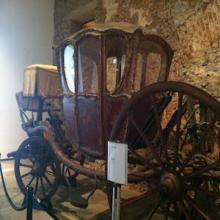
Brazilian Carriage
This horse-drawn carriage dates from the late-eighteenth or early nineteenth century. During this period, carriages like this were the preferred form of transportation for elite members of society. It protected them from inclement weather and created a spectacle among the rest of the townspeople who saw them ride by.
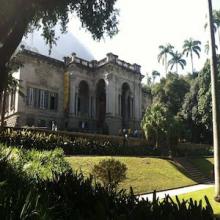
Parque Lage
The Parque Lage is located in the heart of Rio de Janeiro, and at the foot of the Christ the Redeemer mountain. The site features lush gardens and a nineteenth-century mansion. Its name originates from the former residents of the home, Henrique Lage and Gabriella Besanzoni.

First Sounds of the Hymn of Independence
The nation of Brazil declared its independence from Portugal on September 7, 1822 after three centuries of colonial rule. At this time, Brazil was ruled by Emperor Pedro I (1822-1831). It joined the many other nations that declared their independence during this period across the former Portuguese and Spanish empires.
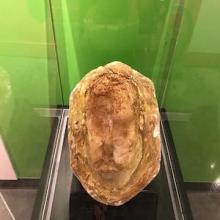
Death Mask of Pancho Villa
Pancho Villa (1878-1923) was a leading figure in the Mexican Revolution, which lasted from 1910-1920. The revolution began with the overthrow of President Porfirio Diaz, who had been in power for 31 years. Over the next decade, elite figures vied for power, and agrarian insurrection ravaged the country.
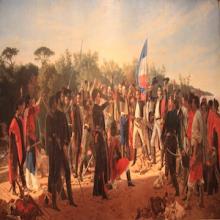
The 33 Orientales
In 1825, Uruguayan troops won their independence from Brazil. The military contingent became known as the “33 Orientales,” reflecting the number of participants and referencing the name of the region (Oriente). Between 1875 and 1878, Juan Manuel Blanes captured a version of these events on oil and canvas.
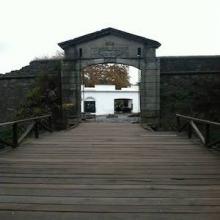
Portón de Campo
This stone structure, also known as the Puerta de la Ciudadela, belonged to the historic defensive walls of Colonia del Sacramento. Although the city is located in modern-day Uruguay, at the time of construction (1745), it was occupied by the Portuguese under Governor Vasconcellos.

Eighteenth-Century Uruguayan Home
On display here are several objects from the Museo Casa de Nacarello, a small museum in Colonia, Uruguay that aims to recreate daily life in an eighteenth-century home. The building that houses the museum dates from that period, and it contains furniture, dishes, and decorations that residents of Colonia would have used at the time.
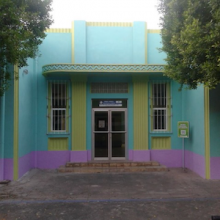
Museo Regional de Oriente
The Museo Regional de Oriente is a state-run history and anthropology museum in San Miguel, El Salvador. The complex that houses this institution began as a textile factory in the 1940s. In the 1980s, during the Guerra Civil (civil war), the Salvadoran military operated out of these structures, which housed the infantry battalion.
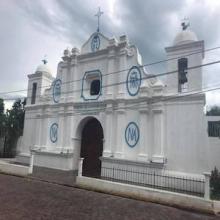
Iglesia Colonial de Conchagua
The Iglesia Colonial de Conchagua is one of the oldest churches in El Salvador. It stands in the shadows of the town’s namesake feature, the Conchagua volcano.